I’ve barely been online all day. What a change.
Today we went to Chartres.
I have great memories of this place, which intimately tied with my personal history.
Great controversy surrounds the cleaning of the interior.
People will ask me what I think….

I’ve already told you about the stupidity of altars like this.
Here’s a little feminist nun catnip.
What to say?
Back in Paris, I saw this “Nehru” jacket.
… a clerical option?
What drink is this?
Supper.. artichoke….
Some wine… pretty okay as it turned out!
The veal chop was only about 1 1/4 inches thick.
After supper a stroll up to the bridge to catch a glimpse of the Tower sparkling at the top of the hour and then back to the hotel for a night cap and sleeeeeeep…..
… after calling my Mother for Mother’s Day.



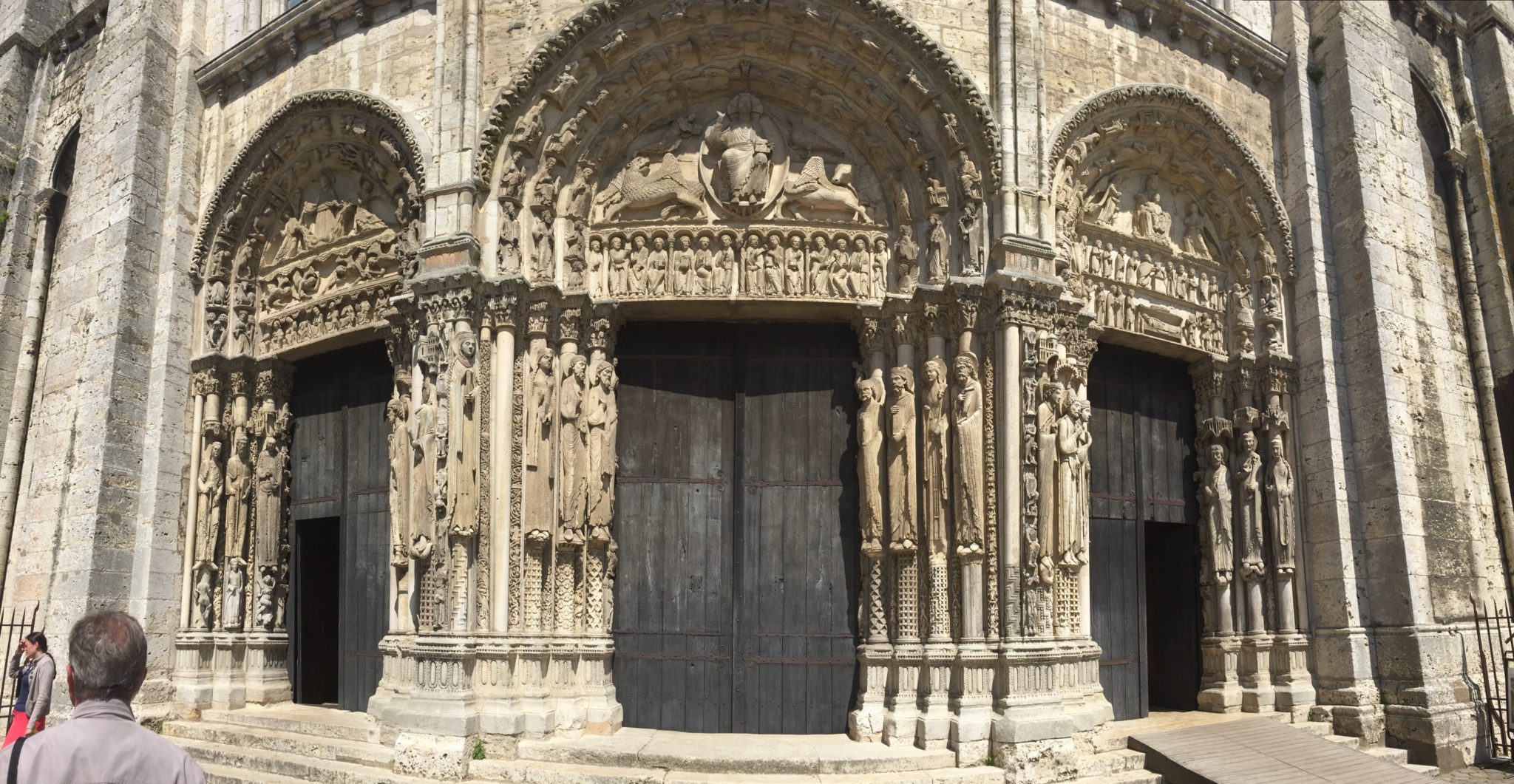
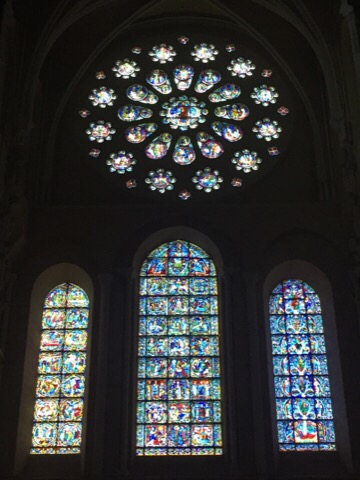

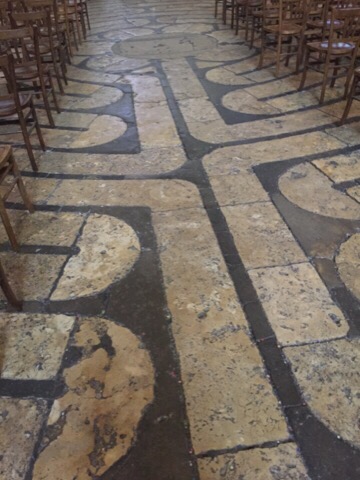
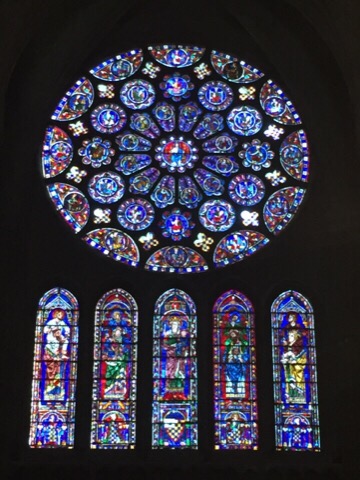
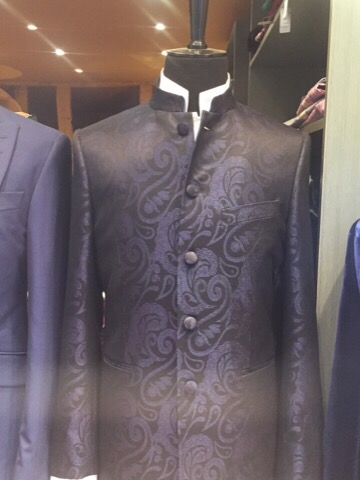




































Now that is a church that calls to me from afar, saying, “Andrew, Andrew, this way, come to me.” Too bad it would take a boat ride to get to it… maybe after I’ve retired, God willing, they will have built a bridge over the Bering Strait.
“I have great memories of this place, which intimately tied with my personal history.” We’d love to know more.
Thanks for posting the photo’s as I have never been to France. I will vote in favor of the cleaning, but I also have to wonder what happened to the original altar? The labyrinth is comforting simply because it demonstrates the ones built recently are not the sole design of the liberal, new age types. The drink chartreuse, and the artichoke looks fantastic too.
Maybe it is meant to be funny but “flamboyant” comes to mind as an adjective for the paisley “clerical jacket”. I vote no. I vote for simplicity in street clothes.
Historically all we know about what the labyrinth was “for” was that it originally had a plaque in the middle of the minotaur, and that the minor clerics (ie boys at the cathedral school) liked to play a ball game on it, and sometimes had to be corrected for doing so during Mass.
The idea of meditatively walking on the labyrinth originates with an anglican lady-priest from San Francisco who had a philosophy of it about walking inward toward Christ then going away/beyond Him on the way back out of the labyrinth. I learned about the anglican lady-priest as the originator of the modernist labyrinth devotion in a brochure about the labyrinth from the local motherhouse of sisters here.
I don’t hate the cleaning of the walls. I do hate the freestanding altar.
I don’t know about the cleaning, I’m a bit torn. On the one hand, it is nice to see the place as it would have looked back in the 13th century, but then antiques come to mind where removing the “patina” is an amateurish mistake. In some sense, these cleaning projects almost smell of “restorationism” and “primitivism” – an attempt to return to an earlier, purer state and to turn our backs on the history, the lived history, the tradition, since. Everything also tends to look a bit too clean. Too new. Too bright.
I always enjoy your travel photos Fr. but a day that includes a visit to Chartres Cathedral is for me a particularly excellent day!! She is magnificent, as always. Interesting to see your photo of the contrast between the cleaned interior next to the old.
During college I studied Gothic architecture for a semester in Chartres. While being somewhat conflicted about the cleaning (or restoration?), it seems to me that the original stone would have been dramatically “brighter” than what I saw decades ago. The interior stone of the basilica in Vezelay was then noticeably brighter than Chartres, as was St. Benoit’s. Perhaps my reservations relate more to my skepticism that the French hierarchy could make any reasonably correct decision about anything… They do eat and drink very well. But it would be well to know which historical trauma knocked them off track. They sure had a treasury of sanctity for a while. What DO you think of the work at Chartres, Father Z?
After visiting the Sistine Chapel following its restoration I was thankful to see the original work. The look brings us to the mindset of those days of faith that inspired such beauty that can only originate from God. It gives us a glimpse of what God put into their minds and how these men of faith applied this inspiration in its original divinely inspired form.
I’m slightly envious, Father Z. Your photos bring back memories of my one and only trip to France ~27 years ago, including three Cathedrals – Notre Dame, Chartres, and Reims.
I have hopes of going back in two or three years. I was chatting with a friend today about my intention to read up on WWI history – both general and family. I’d like to trace my grandfather’s movements on the centennial of his US Army service.
The little box altars are very common in France. The advantage of being so small is they do not dominate the church and the high altar usually remains at least visible. The FSSP managed priestly ordinations using the altar shown last June and the priests use one such for the TLM at St Germain l’Auxerrois in Paris every Sunday at 09:45. They would also be fairly easy to cart away……….
Can you imagine the media meltdown if an orthodox priest was to buy one of those options! Pictures of it and the pope’s frayed cuffs would ring the world! To me, the visibly frayed cuffs mean that either his laundress or the pope didn’t have a pair of scissors to trim off the fray.
Thank you Père for the wonderful photos of Chartres.
Anyone who wishes to see the celebrated labyrinth in its full glory (? ) can see it on a Friday when it is uncovered otherwise it is always covered with chairs. I did not know this until my visit last year which happened to be on a Friday and I was astonished to see so many people wandering round the labyrinth heads down seemingly oblivious to the beauty that surrounded them. They looked like zombies! At the same time the chapel of the Blessed Sacrament was empty…..
It is always annoying to find out later about something of interest after having visited a place. I learnt yesterday that a holy German Priest who is now a Servant of God, Fr Franz Stock, is buried in a church in Chartres. Presumably if and when he is beatified and subsequently canonised his body many be removed back to his homeland but at present he lies in the church of St Jean-Baptiste in the Rue de la Paix.
I’m hesitant to say this, because obviously people’s feelings are much involved.
But would it really be reverent to keep a church dirty and sooty, on purpose? And if it were the intention of medieval people to do that, why did they go to all the trouble to restore and clean and repaint the church in the 15th century?
Gothic cathedrals were designed to be bright and heavenly and airy. If they’d wanted to use black stone, they could have. If they’d wanted to paint the insides of the church black, there was plenty of charcoal and oak gall in the world for them to paint the walls that way. But they didn’t. Black walls would have been seen as more symbolic of Hell than of Heaven.
Also, the art history people are saying that Chartres’ Madonna wasn’t “black” until the 1800’s, so that’s kinda late.
“Here’s a little feminist nun catnip.” I can’t stop laughing.
Let’s look upon this cleaning of the Cathedral as an opportunity to glimpse into heaven, a place of light, happiness and peace.
Now for some sarcasim. The cleaning will make it nice for when it becomes a mosque.
The problem is, in reply to several comments, is that it DOES NOT look like it did in the 13th century! It would have been polychrome painted, in intense colours, quite dark. The extraordinary pink and pale blues of the marbling and wall panels of the Choir, and the lime-wash, (which is on partly 18th century work anyway) is truly horrible, and without any precedent. As commentators have said, the windows are much diminished, the dark dirty interior would have been far closer in tone to the original gloom. Electric light exacerbates the whole effect, as of course the building was lit only by the windows until the 20th century.
The intention of the restoration of Chartres cathedral–from what I’ve read–is to make it look like it did in the 13th century. One can only hope that includes the removal of the freestanding altar and the return of celebrating Mass on the magnificent high altar.
Orson Welles on Chartres:
https://www.youtube.com/watch?v=ksmjh8LL2zA
For Bardophiles: so far as I can tell, the “forked radish” saying is from Shakespeare’s Falstaff, and was gleefully quoted by both of the preeminent Falstaffs of the 20th century–Welles here, and Chesterton in “The Coloured Lands.”
Sorry, can’t find the link right now but, talking of clerical styles, it seems that there is a big event in Vicenza, Italy, where some… shall we say interesting… vestments are part of the wares on display.
The rudest people that I encountered in all of France were at Chartres. I wonder why?
Fr. Z.: if you are still about the Chartres cathedral when you get this, I have an assignment for you: in the basement of the cathedral is a hole in the ground surrounded by a short stone wall. The hole is perhaps a foot across. (I was there in 1997 with a group of World Youth Day participants from Holy Redeemer Parish. The memory is quite old by now.) The hole was/is VERY deep.
Your assignment, should you choose to accept it, is to determine what the purpose of that hole is or was. I suppose it could be a well. Someone suggested it was an oubliette (!!). I have no idea what it actually is. I think someone told me it was lit up on certain festive days.
Rich
Father,
If memory serves me correct, that is actually a Chinese suit jacket with a mandarin collar. It’s not a Nehru jacket because there is still a gap in the collar when the button is done up, whereas the Nehru jacket has no gap when the collar is done up.
On a side note I have seen that jacket in straight black, with all but the top button done up and a white shirt underneath. It looked on first glance as if the person was wearing half a cassock.